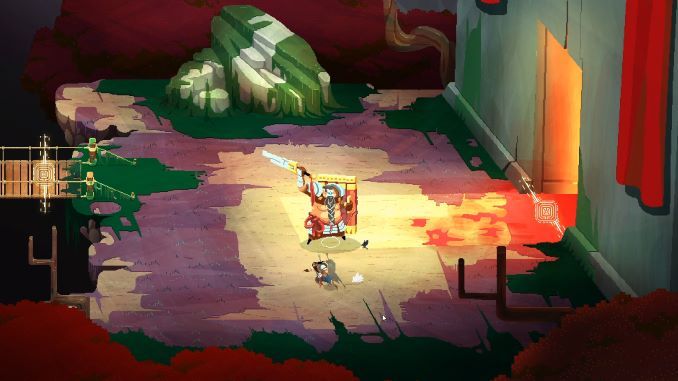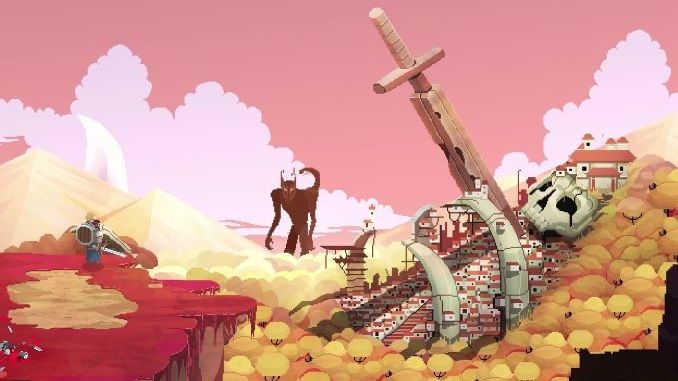Consciously or unconsciously, it’s difficult to get out from under the media that shaped us. So it’s best to not be shy or to be devotional. Rather, it’s good to be casual and gestural, to rely on understanding your work as one node in a network of meaning, neither living up to nor disappointing what preceded it. If I ever get around to writing science fiction about warring religious orders, George Lucas, Ursula K. Le Guin, and Joseph Smith Jr. will be lounging on that story’s furniture, munching on nuts from its dishes, and drinking wine from its glasses. There’s no shame in that.
But there is also the detestable homage, the work that deigns to claim its influences’ power merely because it has those influences. It’s the divine right of kings for media properties. Enter No Place for Bravery, which pulls on a variety of influences but only manages to catch their shadows. Though the effort is obviously impassioned, the effect is of idle enthusiasts’ vacant imaginations. The game holds up questions like “what if Dark Souls was more like God of War?” as potent genre reinventions when it is nothing but tired. Using this kind of crass comparative is glib, but it’s the only way one can really get at what No Place for Bravery is doing. It’s a sleeve so sown with influences the fabric has stretched thin.
Though the marketing touts Sekiro, No Place for Bravery’s primary influence is Dark Souls. It joins the company of Salt and Sanctuary, Tunic, and countless other indie titles that try to augment From Software’s now signature style into a more contained setting. Along this line, No Place for Bravery has some successes. Each weapon, including a sword, a hammer, and crossbow, has pros and cons and a distinctive feel. Parrying is awkward, but useful. While the game never outright requires it, you’d be hard pressed to make it through many of the games’ encounters and boss battles without a few parries. Smartly, No Place for Bravery does not try to replicate the scope of Souls’ weapons and spells, rather containing its action to a small set of clearly defined tools. Then it tests you in rote, but bracing, boss battles.
There are enough quibbles to keep it from being a striking or exceptional action game. In particular, the game’s animations can be very hard to read. The detailed pixel art is expressive but loose and it can be difficult to tell where my body begins and ends and where attacks come from. The problem gets exacerbated with large amounts of enemies or when the perspective zooms out. There are also no enemies that really test your mettle, at least on the standard difficulty. Once you understand the game’s basic toolset, you can anticipate more or less every challenge it will throw at you. It’s also pretty quick; my run time ran about seven hours, which is far less time than any of its influences will ask of you.
However, its successes feel limited when it comes to the overall structure. In a broad sense, you explore the world in the same ways as Souls: you fight enemies through an interconnected environment, regain health potions at safe havens, concluding with a boss battle that introduces the next set of narrative beats. It’s less flexible, in that there’s no optional bosses or skipping around, but that’s a consequence of the scale and length, rather than quality. The problem is that it is not expressive. Dark Souls operates on a kind of material logic; it’s not only level design, it’s architecture. No Place for Bravery makes its world merely a set of connected combat arenas. All of its primary visual ideas feel more like indulgent homage than something carved out of a particular world or story. You feel not as though you were learning a place, but rather getting the ins and outs of a tileset.

Though Dark Souls can get extravagant, especially in later entries, it does understand that simple brutality is enough: the slamming force of a stab in the back, the iron groan of a sword being pulled from an open mouth, hands withering as they reach for your throat. In contrast, No Place for Bravery leans on flashy animated touches, clumsily gruesome execution animations, and constant fades and cuts (though always from the same 2D perspective). It hides its constraints behind a curtain woven of cheap tricks. Though the great wizard’s voice booms, you know there’s just a little man in there, placing every pixel.
The problem here is not exactly that the game is ambitious, or even that it reaches beyond its grasp, but that it doesn’t have the good sense to lean into its limitations. It’s shocking how varied and expressive a game like Final Fantasy IV can feel, with a scant few gestures and little animations. It’s the kind of effect that a single person could make now with RPG Maker and some drawing skill and/or pixel draftsmanship. No Place for Bravery has more tools, but feels constrained rather than free.
In a similar vein, the game’s primary move away from Souls is its more cinematic and straightforward storytelling mode. Dark Souls is literary in that it asks for your interpretation, for you to take the time to put things together. The necessity of reading item descriptions to understand the nuances of the narrative indicates how the game urges you to puzzle things out. That’s not an assessment of quality, though I quite like Dark Souls, but a question of what the game is asking you to do. No Place for Bravery, on the other hand, is all surfaces. Whereas reading item descriptions in Dark Souls can feel like surveying meaningful pieces of an alien world, No Place for Bravery summons up lore in frivolous bites. If you pick up an item or enter into a new area, “new lore unlocked,” like some pesky Facebook notification, flashes across the screen. It makes the world that the protagonist kills his way through only junk food to be consumed.
In the broad strokes, the game pulls a similar narrative trick to Drakengard, where its initial endings offer some quiet redemption, but subsequent ones reveal escalating horrors. Protagonist Thorn’s search for his missing daughter, alongside his disabled son Phid, is obviously ill-advised. The further he goes, the more dangerous and morally fraught work he must do. This descent into hell could land if Thorn was a psychologically complex character, or even if the game could summon something truly dream-like or surprising. Alas, Thorn is an object lesson, not a person. The innocents he kills are just part of a pantheon of well-meaning saints, as flat as a print of stained glass. Every image it summons, mostly of giant corpses decaying or dying, is deeply obvious.
The fact remains, though, that No Place for Bravery exists and my stories do not. It is easy to say that MY influences are cool and tasteful when you haven’t put pen to page or code to compiler. While games of a certain size are made more by a machine that eats human beings than by human beings themselves, No Place for Bravery is small enough for very personable touches. I hate panning things in light of that knowledge. This is a small enough game that the developers could read every single review. It is easy to want to hold back because of that human eye. I, after all, would like people to like my still imaginary work. Holding back, though, is just playing. It treats a game (or a movie or a book) as no worthwhile object of its own, but merely a bolster to the ego of a stranger. Treating something seriously means treating your own reaction seriously. Allowing it to weather or crumble under your second guesses is part of the process, but what remains after all that is probably something true and real. That is the care of being a critic. Even detestable homage deserves that respect.
No Place for Bravery was developed by Glitch Factory and published by Ysbryd Games. Our review is based on the PC version. It is also available for Switch.
Grace Benfell is a queer woman, critic, and aspiring fan fiction author. She writes on her blog Grace in the Machine and can be found @grace_machine on Twitter.

